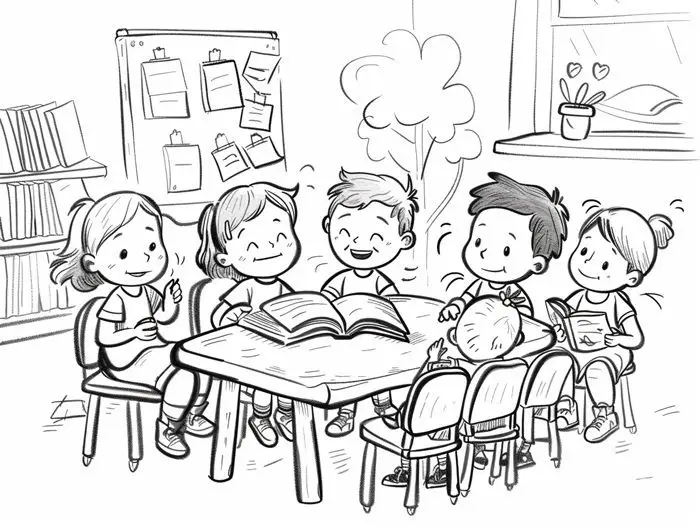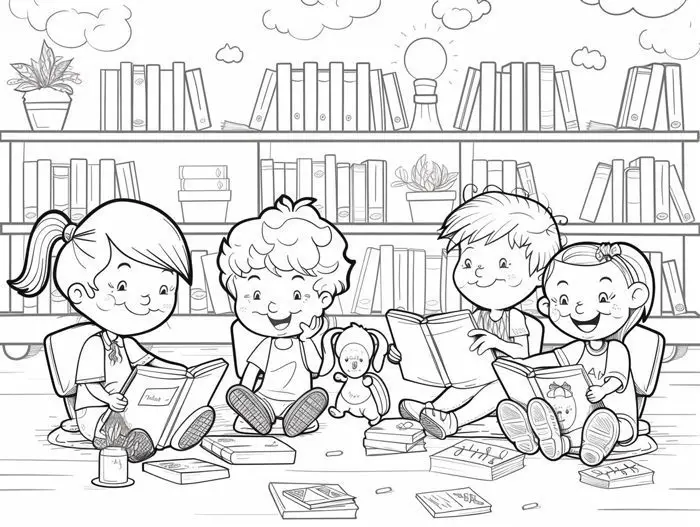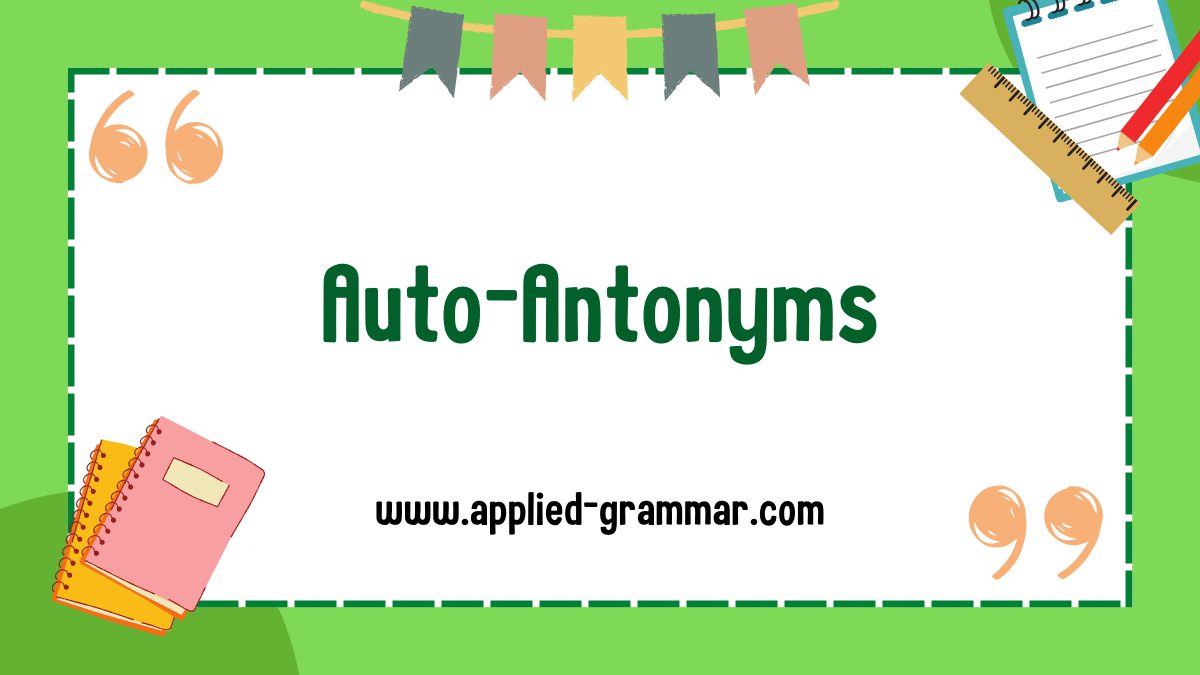Have you ever come across words that can mean two completely opposite things? Words that can be their own antonyms? These linguistic marvels are known as auto antonyms, or contronyms. They add a fascinating twist to the English language, challenging our understanding and keeping us on our toes.
Auto antonyms are words that have contradictory meanings depending on the context in which they are used. They can be a source of confusion and amusement, and they highlight the complexity and versatility of language. Imagine a word that can mean “to quit” and “to renew” or “to ban” and “to bless.” It’s like a linguistic rollercoaster ride, where the meaning can change in an instant.
In this text, we will explore the intriguing world of auto antonyms. We will investigate into some examples, uncover the reasons behind their existence, and discuss the impact they have on our everyday communication. So, buckle up and get ready to unravel the enigmatic nature of these words that can be their own opposites.
Key Takeaways
- Auto antonyms are words that have contradictory meanings depending on the context in which they are used.
- Auto antonyms add complexity and versatility to the English language, often leading to confusion and amusement.
- Auto antonyms can be found in various parts of speech, including verbs, nouns, adjectives, and adverbs.
- Reversible auto antonyms can switch between opposite meanings depending on the context, while irreversible auto antonyms have meanings that cannot be reversed.
- Reciprocal auto antonyms describe actions or relationships that involve multiple parties and have opposite meanings depending on the party involved.
- Understanding auto antonyms can enhance communication skills, expand vocabulary, and challenge critical thinking.
What are Auto Antonyms?

Definition of Auto Antonyms
Auto antonyms, also known as contronyms or Janus words, are words that have contradictory meanings depending on the context in which they are used. These words add complexity and versatility to the English language, often leading to confusion and amusement. Auto antonyms can be found in various parts of speech, including verbs, nouns, adjectives, and adverbs.
To help you understand better, here are some key terms related to auto antonyms:
- Contronyms: Another term for auto antonyms, referring to words that have opposite meanings depending on the context.
- Janus words: Named after Janus, the Roman god with two faces, these words simultaneously represent two opposite meanings.
- Context-dependent: Auto antonyms change their meanings depending on the context in which they are used. The same word can have two contradictory definitions.
Examples of Auto Antonyms
Auto antonyms can be found in everyday language and literature. Here are some commonly used examples to illustrate this linguistic phenomenon:
- Bolt:
- Definition 1: To secure or fasten tightly.
- Definition 2: To flee or run away swiftly.
- Dust:
- Definition 1: To remove dust or clean a surface.
- Definition 2: To sprinkle dust or scatter particles.
- Left:
- Definition 1: To depart or go away from a place.
- Definition 2: Remaining or still present in a place.
- Overlook:
- Definition 1: To intentionally ignore or disregard something.
- Definition 2: To have a view from above, often providing a panoramic perspective.
- Cleave:
- Definition 1: To split or separate into two parts.
- Definition 2: To cling or adhere firmly together.
These examples showcase the complexity and versatility of auto antonyms in the English language. It’s important to consider the context in which these words are used to avoid any confusion or misinterpretation.
Auto antonyms provide a unique linguistic experience that challenges our understanding of words and their meanings. Understanding auto antonyms can help improve communication skills and enhance our appreciation for the intricacies of the English language.
Types of Auto Antonyms

Reversible Auto Antonyms
Reversible auto antonyms are words that can switch between opposite meanings depending on the context in which they are used. These words can be both intriguing and confusing, as they require careful interpretation to determine their intended meaning. Here are some examples:
- Buckle: It can mean both “to pull together” and “to fall apart.” The meaning of this word depends on the specific situation it is used in.
- Charge: This word can convey both “to add to” and “to take away from.” Its meaning is determined by the context in which it is used.
Understanding reversible auto antonyms requires paying close attention to the surrounding context to correctly interpret the intended meaning of the word.
Irreversible Auto Antonyms
Irreversible auto antonyms, as the name suggests, have meanings that cannot be interchanged or reversed. These words have opposite meanings, with no possibility for ambiguity. Some examples of irreversible auto antonyms include:
- Continue: It means “to proceed” and is the opposite of “to interrupt.” When you want something to keep going without any breaks, you would use “continue.”
- Drop: It can mean “to terminate” as well as “to overlook.” The meaning depends on the context, such as dropping a particular course or dropping someone from a list.
With irreversible auto antonyms, there is no need to consider the context extensively, as the opposite meanings are clear-cut.
Reciprocal Auto Antonyms
Reciprocal auto antonyms are words that describe actions or relationships that involve multiple parties. These words have opposite meanings depending on which party is the subject or object of the action. Here are a few examples:
- Screen: It can mean “to show” as well as “to hide.” When you screen a movie, you are displaying it to an audience. But, if someone screens a movie for you, it means they prevented you from seeing it.
- Secure: It can convey “to protect from being taken” or “to obtain from.” When you secure your belongings, you make them safe from theft. On the other hand, if you secure something from someone, it means you obtain it from them.
Reciprocal auto antonyms add an extra layer of complexity to language, requiring consideration of the roles of different parties involved in the action or relationship.
Auto antonyms, whether reversible, irreversible, or reciprocal, showcase the multilayered and nuanced nature of the English language. Understanding these words can enhance your communication skills and deepen your appreciation for the intricacies of language.
Remember to pay attention to the context in which these words are used to ensure clarity and avoid any misinterpretations.
Challenges in Understanding Auto Antonyms
In the area of language, auto antonyms present a unique challenge. These words, also known as contronyms or Janus words, possess opposite meanings depending on the context in which they are used. While auto antonyms can be fascinating and intriguing, they can also create confusion and difficulty in interpretation. Let’s explore some of the challenges that arise when trying to understand auto antonyms.

Confusion in Interpretation
One of the primary challenges in comprehending auto antonyms stems from the potential for misinterpretation. When encountering such words, it can be challenging to discern their intended meaning without proper context. Without a clear understanding of the context, you may find yourself interpreting the word in a manner that contradicts its actual intended meaning. This can lead to errors in communication and a breakdown in understanding.
To illustrate this, consider the word “screen.” On one hand, it can mean to show or display, as in “the critics screened the movie.” On the other hand, it can also mean to hide or shield, as in “the critics screened the movie, so I couldn’t watch it.” Without the appropriate context, it is easy to misinterpret the intention behind the word.
Contextual Dependence
Auto antonyms rely heavily on the surrounding context for proper interpretation. The same word can shift its meaning drastically based on the situation in which it is used. This contextual dependence can make it challenging to grasp the intended sense of the word without considering the broader context of the sentence or conversation.
For example, let’s examine the word “secure.” It can imply protection or safety, as in “we secured all our silverware from thieves.” But, it can also mean to obtain or acquire, as in “we secured the necessary permits for the event.” The exact meaning of “secure” can only be determined by evaluating the sentence’s context, making its interpretation more complex.
Understanding auto antonyms requires a careful consideration of the surrounding words, sentences, and broader communication context. Focusing to the context, you can accurately decipher the intended meaning of these intricate and versatile words.
To summarize, interpreting auto antonyms presents challenges due to the potential for confusion in interpretation and their heavy dependence on context. By understanding these challenges, you can navigate the complexities of auto antonyms more effectively and enhance your communication skills in the process.
Importance of Auto Antonyms
Auto antonyms, also known as contronyms or Janus words, play a crucial role in language and communication. Understanding the significance of auto antonyms is essential for effective communication and avoiding misunderstandings. In this section, we will explore why auto antonyms matter and how their proper utilization can enhance your language skills.

What are Auto Antonyms?
Before delving into the importance of auto antonyms, let’s briefly define what they are. Auto antonyms are words that have opposite meanings depending on the context in which they are used. These versatile words can be misleading if not properly understood, as they can convey contradictory meanings based on the surrounding words and the overall context of the sentence or conversation.
Enhancing Communication
One of the primary reasons why auto antonyms are important is because they challenge us to be more mindful of the words we use and how we interpret them. Understanding the dual nature of these words allows us to communicate with more precision and avoid potential confusion. By being aware of the context and selecting the appropriate meaning for an auto antonym, we can ensure that our message is conveyed accurately.
Expanding Vocabulary
Auto antonyms provide an opportunity to expand our vocabulary and deepen our understanding of language. By familiarizing ourselves with these words and their contrasting meanings, we can broaden our linguistic capabilities and express ourselves more effectively. Plus, they add richness and nuance to our communication, allowing us to convey subtle shades of meaning.
Challenging Our Thinking
Auto antonyms also challenge us to think critically and analyze language in a more nuanced way. They encourage us to consider the context and the intended meaning behind the words we encounter. Engaging with auto antonyms can train our minds to approach language from different perspectives, fostering critical thinking skills and promoting a deeper understanding of communication.
Summary
Summarizing, understanding the importance of auto antonyms is crucial for effective communication and language development. By recognizing these words and their dual meanings, we can enhance our communication skills, expand our vocabulary, and challenge our thinking. So, embrace the complexity of auto antonyms and reap the benefits of mastering these unique linguistic phenomena.
Famous Examples of Auto Antonyms
Auto antonyms, also known as contronyms or Janus words, are words that have two opposite meanings depending on the context. They challenge our understanding and interpretation of language, forcing us to be more mindful of the words we use and how we use them. In this section, we will explore some famous examples of auto antonyms and investigate into their dual nature.

Sanction
One word that exemplifies the concept of auto antonyms is “sanction.” On one hand, it can mean to bless or approve, as in the context of a religious ceremony or official endorsement. On the other hand, it can mean to ban or impose penalties, such as economic sanctions on a country. This dual nature of “sanction” showcases how a single word can have contradictory meanings.
Left
Another fascinating auto antonym is the word “left.” While it commonly refers to the opposite of right, it can also have two opposite meanings depending on the context. In one sense, “left” can mean remaining or staying behind, as in “the only people left in the room were the staff.” In another sense, “left” can mean departed or gone, as in “after the guests left, the cleaning crew arrived.” This dual meaning of “left” demonstrates the complexity of auto antonyms and how they can flip the interpretation of a word.
Custom
The word “custom” is yet another example of an auto antonym. On one hand, it can refer to a tradition or practice that is handed down through generations, such as cultural customs. On the other hand, it can mean something that is specially made or tailored for an individual, like a custom-made suit. This dual interpretation of “custom” illustrates how auto antonyms can challenge our understanding of words and require us to consider the context in which they are used.
Auto antonyms, with their contradictory meanings, serve as a reminder that language is often nuanced and context-dependent. Understanding and recognizing auto antonyms can enhance our communication skills, improve our language development, and encourage critical thinking. By being mindful of the words we use and their potential dualities, we can communicate more precisely and effectively.
Now that we have explored some famous examples of auto antonyms, let’s dive deeper into the impact and implications of these linguistic phenomena.
Conclusion
Recognizing and understanding auto antonyms, also known as contronyms or Janus words, can greatly enhance your communication skills. These words have two opposite meanings depending on the context, making them intriguing and sometimes confusing. By being aware of their dual nature, you can avoid misunderstandings and communicate more effectively.
Auto antonyms, such as “sanction,” “left,” and “custom,” remind us that language is nuanced and context-dependent. They challenge us to think critically and consider the specific context in which a word is used. This encourages us to be more precise in our language and to choose our words carefully.
By incorporating auto antonyms into your vocabulary, you can improve your language development and become a more skilled communicator. These words add depth and complexity to your conversations and writing, allowing you to express ideas with greater precision.
To conclude, auto antonyms are fascinating linguistic phenomena that highlight the intricacies of language. By embracing their dualities, you can navigate the complexities of communication more effectively and become a more proficient language user.
